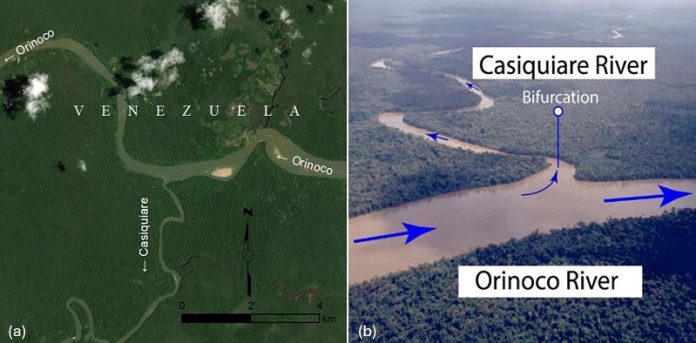
Most rivers follow a few basic rules: they flow downhill, join other rivers, and eventually end up in the ocean or a lake.
But a new study has found that not all rivers play by these rules. In fact, some rivers seem to go in multiple directions—or even split apart without ever coming back together.
In a paper published in Water Resources Research, scientists Scott Sowby and Donald Siegel describe nine strange rivers and lakes in North and South America that defy expectations.
These rivers show “bifurcation,” which means they split into two branches. But unlike normal river splits, these branches don’t rejoin the main river—they keep flowing away separately.
One of the most fascinating examples is the Casiquiare River in South America.
It connects two of the continent’s biggest river systems—the Orinoco and the Amazon. The Casiquiare acts as both an exit for the Orinoco and an entry point for the Amazon.
The researchers call it “a hydrologic wormhole,” like a shortcut between two different water worlds. This unusual setup happens because the land is very flat—just a tiny slope (less than 0.009%) is enough to keep the water flowing.
Another strange river is the Wayambo River in Suriname. First mapped by Dutch colonists in 1717, it can flow either east or west, depending on how much it rains and how people adjust water levels using locks.
This makes it hard to predict where pollutants might spread, especially near nearby gold and oil mining sites.
But perhaps the most puzzling river is the Echimamish River in remote Canada. Its name means “water that flows both ways” in the Cree language. It links two larger rivers—the Hayes and the Nelson—and seems to flow outward from its center.
The river is so flat and full of beaver dams that scientists still aren’t sure exactly which way the water moves, or where the direction changes.
The researchers also looked at six other odd waterways, including lakes that have two outlets and creeks that drain into both the Atlantic and Pacific Oceans. These examples remind us that Earth’s water systems are more complex than we think.
Even with all our modern tools, there’s still so much we don’t fully understand about rivers and how they behave.
As Sowby and Siegel point out, sometimes nature breaks its own rules—and that’s when things get interesting.



